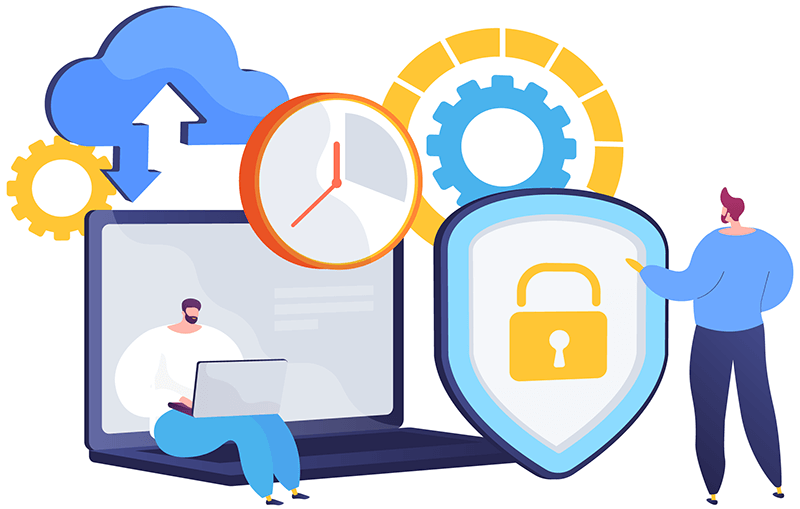Ensuring the safety and availability of your business data is crucial. That is why any organization needs to prioritize the implementation of reliable data backup and recovery strategies. Here is why you should care:
- Protect against risks. Proper backup measures shield your valuable data from risks, including human error, equipment failures, and cyberattacks. They act as a safety net, preventing the disastrous consequences of permanent data loss.
- Natural disaster resilience. Unforeseen events like natural disasters can devastate businesses. Studies reveal that many small businesses never recover after experiencing such disasters. Around 40% fail to reopen, and of those that do, an additional 25% end up shutting down within a year.
- Robust plans for resilience. It is crucial to have strong data backup and recovery plans to withstand challenging circumstances. These plans should be capable of navigating through the most demanding scenarios.
- Explore data backup options. Understanding the different types of data backup available is essential. This knowledge allows you to select the most suitable approach for your business, ensuring the ongoing protection and accessibility of your valuable data.
- Optimal data recovery methods. It is essential to explore the best ways for data recovery. Implementing these strategies enables you to effectively retrieve your data in unforeseen data loss incidents.
By prioritizing reliable data backup and recovery strategies and leveraging the proper techniques for your business, you can safeguard your data and maintain its accessibility, thereby ensuring the long-term success of your organization.

4 Levels of data backup: exploring the best options for data storage
Ensuring the safety and availability of your business data is crucial. Let us delve into the four levels of data backup and discover the most suitable options for storing your valuable information:
Level zero: the risks of no data backup
- Shockingly, some companies still lack backup strategies, often due to concerns about expenses or a false belief that disasters will not happen to them.
- Small and medium businesses, however, accounted for 43% of data breach victims in 2019, making it clear that data loss risks are prevalent and should not be ignored.
Level 1: local backup - fast and controlled data protection
- A local backup solution, such as external or magnetic tape drives, provides fast backup and restore times, allowing you to control data access.
- While having an additional copy of your files on-site is a good step, it may not be sufficient to protect against data loss caused by disasters, cyberattacks, user errors, or hardware malfunctions.
Level 2: hybrid cloud backups - redundancy and enhanced data security
- Hybrid cloud backups combine local, private, and public cloud storage to ensure redundancy.
- Storing data in multiple locations provides both a local copy and a securely stored offsite copy, enhancing data protection and availability.
Level 3: cloud backup - safeguarding data without physical dependencies
- Backing up data to the cloud eliminates the need for local storage devices. It ensures data safety even in the face of physical infrastructure damage.
- However, the speed of backups may depend on your internet connection, so it is essential to consider the impact on backup times.
It is worth considering that data backup strategies should align with your business needs and priorities. By selecting the most suitable level of data backup, you can ensure the safety, accessibility, and resilience of your critical data in the event of disasters, cyber threats, or unexpected data breaches.
Exploring different types of data backup for effective protection
3-2-1 backup: reliable data preservation
The 3-2-1 backup strategy involves maintaining the original production data and two backup copies of your data. These copies should be stored separately, even in the exact location. One copy should be kept offsite in another office, data center, or the cloud. This method provides reliable data preservation in case of failures or data loss.
Differential backup: capturing changed data
Differential backups copy only the files that have changed since the last full backup. This approach includes data created, updated, or altered without duplicating all the data each time. It helps minimize storage and network usage.
GFS (Grandfather-Father-Son) backup: structured backup rotation
GFS is a popular backup strategy that organizes backups into manageable timelines. It involves daily backups (“sons”), weekly backups (“fathers”), and monthly backups (“grandfathers”). The backups rotate using a FIFO (first in, first out) system, ensuring data retention at different intervals.
Incremental backup: efficient daily changes
Incremental backups focus on capturing only the files that have changed since the last backup. For instance, after a full backup on Monday, Tuesday’s incremental backup will only contain the data changed since Monday. Incremental backups are efficient and require fewer resources, but data recovery may take longer than other methods.
Full backup: creating a complete copy
A full backup involves completely copying all files on a system or drive. While it provides comprehensive data backup, it can be resource-intensive due to its significant storage and network resources requirement. Full backups also take longer to complete.
Mirror backup: exact replication
A mirror backup replicates data exactly, similar to a full backup. However, it does not compress the data, resulting in more significant storage space consumption. Although mirror backups offer quick recovery times, they do not retain previous versions of backup data.
Exploring different types of data recovery for effective restore
Backing up your data is only the first step; the true objective of a disaster recovery strategy is to restore your company’s operational data and systems quickly and with minimal data and financial loss. To determine the most suitable data recovery approach, you must establish your goals based on two critical measurements: Recovery Point Objective (RPO) and Recovery Time Objective (RTO). RPO defines the maximum acceptable downtime and determines how frequently backups should be performed to minimize data loss. On the other hand, RTO measures the time required to recover data and get systems back online, with shorter durations often incurring higher costs. By understanding these metrics and their implications, you can make informed decisions about the type of data recovery that best suits your business, ensuring efficient restoration and minimal disruption. Let us explore the fascinating world of data recovery strategies to accomplish these goals.
Backup and disaster recovery (BDR): comprehensive protection
For ultimate protection, you should consider utilizing a backup and disaster recovery (BDR) solution for your business. A BDR solution creates a running copy of all files so you can move to the live backup copy at the flip of a switch in an emergency.
Local device recovery
Recovering backup data from a local device (like an external hard drive or tape drive) is one of the fastest data recovery methods. However, it also has the highest frequency of failure. If constant monitoring policies are instituted, reliability can be improved.
Cloud/hybrid cloud recovery
Backup from the cloud can involve transferring massive amounts of data over your internet connection, which can cause excessive downtime. If you have internet connectivity issues, this can be problematic. The physical distance between your business and your cloud data center can determine recovery time and reliability.
To determine the type of data recovery that’s best for your business, you must establish your goals concerning two measurements: RPO and RTO.
Remember, regardless of the chosen data recovery method, the process should be automated to ensure regular updates. Relying on manual processes can lead to outdated backups, rendering them almost worthless.
Hystax is here to safeguard your precious data
Imagine the consequences if your business stumbles due to a simple oversight like an inadequate backup system. Do not let that happen! Hystax is here to provide your business with the operational security it deserves. Our cutting-edge Backup and Disaster Recovery (BDR) solution offers the ultimate data protection. We ensure your valuable data is securely backed up by redundancy across multiple data centers. And in the unfortunate event of a data loss disaster, our BDR solution swiftly restores your data to a terminal, getting your business back on its feet without skipping a beat.
Do not leave your business vulnerable to data loss and downtime. Join forces with Hystax today and experience peace of mind with the highest data protection level. Reach out to us now, and let us safeguard your business together!



